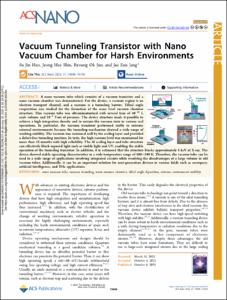Department of Electrical Engineering and Computer Science
Advanced Electronic Devices Research Group(AEDRG) - Jang Lab.
1. Journal Articles
Full metadata record
| DC Field | Value | Language |
|---|---|---|
| dc.contributor.author | Heo, Su Jin | - |
| dc.contributor.author | Shin, Jeong Hee | - |
| dc.contributor.author | Jun, Byoung Ok | - |
| dc.contributor.author | Jang, Jae Eun | - |
| dc.date.accessioned | 2024-01-30T01:40:14Z | - |
| dc.date.available | 2024-01-30T01:40:14Z | - |
| dc.date.created | 2023-11-10 | - |
| dc.date.issued | 2023-10 | - |
| dc.identifier.issn | 1936-0851 | - |
| dc.identifier.uri | http://hdl.handle.net/20.500.11750/47698 | - |
| dc.description.abstract | A nano vacuum tube which consists of a vacuum transistor and a nano vacuum chamber was demonstrated. For the device, a vacuum region is an electron transport channel, and a vacuum is a tunneling barrier. Tilted angle evaporation was studied for the formation of the nano level vacuum chamber structure. This vacuum tube was ultraminiaturized with several tens of 10-18 L scale volume and 10-6 Torr of pressure. The device structure made it possible to achieve a high integration density and to sustain the vacuum state in various real operations. In particular, the vacuum transistor performed stably in extreme external environments because the tunneling mechanism showed a wide range of working stability. The vacuum was sustained well by the sealing layer and provided a defect-free tunneling junction. In tests, the high vacuum level was maintained for more than 15 months with high reliability. The Al sealing layer and tube structure can effectively block exposed light such as visible light and UV, enabling the stable operation of the tunneling transistor. In addition, it is estimated that the structure blocks approximately 5 keV of X-ray. The device showed stable operating characteristics in a wide temperature range of 100-390 K. Therefore, the vacuum tube can be used in a wide range of applications involving integrated circuits while resolving the disadvantages of a large volume in old vacuum tubes. Additionally, it can be an important solution for next-generation devices in various fields such as aerospace, artificial intelligence, and THz applications. © 2023 The Authors. Published by American Chemical Society. | - |
| dc.language | English | - |
| dc.publisher | American Chemical Society | - |
| dc.title | Vacuum Tunneling Transistor with Nano Vacuum Chamber for Harsh Environments | - |
| dc.type | Article | - |
| dc.identifier.doi | 10.1021/acsnano.3c02916 | - |
| dc.identifier.wosid | 001082586800001 | - |
| dc.identifier.scopusid | 2-s2.0-85175271115 | - |
| dc.identifier.bibliographicCitation | ACS Nano, v.17, no.20, pp.19696 - 19708 | - |
| dc.description.isOpenAccess | TRUE | - |
| dc.subject.keywordAuthor | nano vacuum tube | - |
| dc.subject.keywordAuthor | vacuum tunneling | - |
| dc.subject.keywordAuthor | nano vacuumchamber | - |
| dc.subject.keywordAuthor | tilted angle deposition | - |
| dc.subject.keywordAuthor | extreme environmentstability | - |
| dc.subject.keywordPlus | FIELD-EMISSION TRIODE | - |
| dc.subject.keywordPlus | ARRAYS | - |
| dc.subject.keywordPlus | PERFORMANCE | - |
| dc.subject.keywordPlus | FABRICATION | - |
| dc.subject.keywordPlus | CATHODES | - |
| dc.subject.keywordPlus | GRAPHENE | - |
| dc.subject.keywordPlus | VOLTAGE | - |
| dc.citation.endPage | 19708 | - |
| dc.citation.number | 20 | - |
| dc.citation.startPage | 19696 | - |
| dc.citation.title | ACS Nano | - |
| dc.citation.volume | 17 | - |
| dc.description.journalRegisteredClass | scie | - |
| dc.description.journalRegisteredClass | scopus | - |
| dc.relation.journalResearchArea | Chemistry; Science & Technology - Other Topics; Materials Science | - |
| dc.relation.journalWebOfScienceCategory | Chemistry, Multidisciplinary; Chemistry, Physical; Nanoscience & Nanotechnology; Materials Science, Multidisciplinary | - |
| dc.type.docType | Article | - |
- Files in This Item:
-
 기타 데이터 / 10.12 MB / Adobe PDF
download
기타 데이터 / 10.12 MB / Adobe PDF
download



